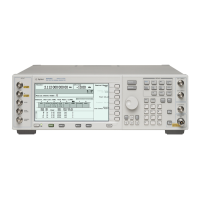Chapter 16 459
W-CDMA Uplink Digital Modulation for Receiver Test
Understanding the PRACH
Example 2:
In this example the data part power will be 40 dB higher than the control part power. Since the Pp-m is set to
0 dB, this means that the control part power level is equivalent to the preamble power. This condition will
create a substantially higher message part power compared to the preamble power, and in most cases, this
would cause the carrier power to readjust itself to compensate for the high message part power.
Example 3:
In this example the control part power is 10 dB less than the preamble power and the data part power is
-23.52 dB (beta of 1) less than the control part power. These settings result in a message part power that is
less than the preamble power.
Power Control Modes
The ESG gives you the opportunity to control your PRACH power using one of two methods, a Pp-m mode
or a Total mode. The mode selection is accomplished using the
PRACH Power Setup Mode Pp-m Total softkey.
Pp-m Power Mode
The Pp-m mode lets you control the message part power by making changes to your control part and data
part power levels. The control part power level is adjusted by entering values in the Pp-m field. There is no
direct message part power adjustment in this mode since the Msg Pwr field is grayed-out (inactive).
However the message part power is shown in the grayed-out field. You can also calculate your message part
power by using the formulas given in the section, “Power Control” on page 453. Figure 16-10 shows the
Pp-m mode selection along with the two fields that were mentioned earlier.
Preamble Power: −40 dBm Pp-m: 0 dB Ctrl Beta: 0 Data Beta: 15
Preamble Power: −40 dBm Pp-m: −10 dB Ctrl Beta: 15 Data Beta: 1

